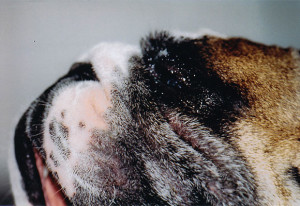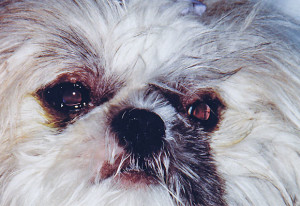Pugs, Shih Tzus, and Pekingese are breeds that were created by humans to look very cute. Unfortunately, the shorter the nose, the shallower the eye socket, and the more prominent the eye. Usually these breeds also have unusually large, round eyelid openings. The result is Macropalpebral Fissure Syndrome . The hallmarks of this condition:

The nasal fold on this English Bulldog is very large and interferes with vision, in addition to rubbing the eyes.
A prominent fold of skin over the nose (“nasal fold”). The hair on the nasal fold can rub on the surface of the eye (“nasal fold trichiasis“). Large nasal folds can also interfere with vision. Abnormal hair growing in the inside corners of the eyes, which is in constant contact with the corneal surface (“medial trichiasis“). This is especially common in Shih Tzus. The skin on the inside corner of the eyes rolls in (“medial entropion“), so that the hair on the surface of the skin also rubs on the cornea, causing irritation and increased rubbing of the face.

Pekingese with prominent eye and corneal ulcer (the green is diagnostic fluorescein dye). Medial Canthoplasty surgery was later performed in both eyes.
A high risk for either or both eyes to proptose (“pop” out of the eye socket) secondary to trauma. Proptosis often leads to blindness and sometimes the affected eye needs to be removed. A high risk for painful corneal ulcers to occur, and potential rupture and loss of the eye if the ulcer perforates. If the ulcer is severe, surgery can be performed to graft tissue into the corneal defect.
A high risk for eye trauma. Dogs with large eyelid openings and prominent eyes often love to rub their faces on the carpet and on furniture, damaging the eyes. This is particularly true in Shih Tzus, where excessive facial hair irritates the eyes if not kept clipped short. Additionally, if these dogs “play” with cats that don’t want to play, cat claw injuries commonly occur — the dog’s bulging, shiny eyes are easy targets for the cat.
Dogs with Macropalpebral Fissure Syndrome are often uncomfortable, and are at significant risk for blindness due to a film-like scar tissue forming on the corneas. Some dogs are blind before they are 5 years old.
Many of these dogs also develop clinically dry eyes , where their tear production and/or tearfilm quality is poor. If the eyes are dry in addition to the above mentioned problems, the dog is at extremely high risk of becoming blind from corneal pigmentation and scar tissue developing. Often, the corneal pigmentation is not noticed until it is quite advanced, as it is a dark brown color and blends in with the natural brown color of the iris. Dogs will not begin to bump into objects until they have lost most of their vision– thus, if you notice a “film” on the surface of your pet’s eyes but your pet is visual, this does not necessarily mean that your dog’s vision is normal, and it is a good idea for your dog’s eyes to be examined by a veterinarian.
Additionally, English Bulldogs, Shih Tzus, and Pugs are prone to developing distichiasis , which are abnormal hairs that grow from the oil glands in the eyelids. These hairs, or “distichia”, can be located anywhere along the lid margin, and can be quite stiff and irritating. Sometimes they can actually grow on the inner surface of the eyelid, rubbing the eyeball like a sharp little needle. These inward-growing hairs are called ectopic cilia and they can be quite painful. See Canine Eyelid Diseases .

Medial canthoplasty postoperative appearance in a Shih Tzu.
Dogs with Macropalpebral Fissure Syndrome are best treated surgically, with a plastic surgery called Medial Canthoplasty, performed by Dr. McCalla at Animal Eye Care. In this surgery, the inside corners of the eyelids are permanently sutured closed, effectively narrowing the eyelid openings and making them more almond-shaped. Additionally, the abnormal hairy tissue on the inside corners of the eyes is removed with this surgery, and the medial entropion is corrected. This surgery does change the appearance of the dog’s face, as well it should. The patient needs to blink better and have less eye exposure to air, and to do this the eyelid openings must be smaller. An added benefit of this surgery is the reduced likelihood that the eye(s) could be proptosed secondary to trauma. Medial canthoplasty surgery does not always prevent future eye problems, but it can greatly reduce the frequency and severity of problems.
The first step in determining if your pet would benefit from medial canthoplasty surgery is to have a comprehensive ophthalmic examination at Animal Eye Care. If your pet also has a dry eye disease, lifetime medical treatment may be required, in addition to medial canthoplasty surgery. If your pet also has either distichiasis or ectopic cilia, surgery to correct these problems will also be discussed and possibly recommended.
Macropalpebral Fissure Syndrome is a common condition that often requires both medical and surgical intervention. Please call Animal Eye Care if you wish to schedule your pet for evaluation of this potentially blinding disease.